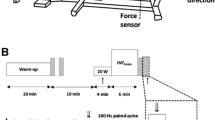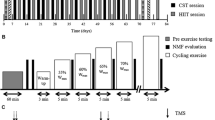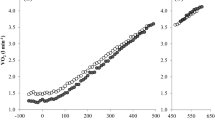Summary
The purpose of this study was to investigate the relationship between anaerobic threshold (Than) and muscle fatigue threshold (EMGFT) as estimated from electromyographic (EMG) data taken from the quadriceps muscles (vastus lateralis) during exercise on a cycle ergometer. The subjects in this study were 20 female college students, including highly trained endurance athletes and untrained sedentary individuals, whose fitness levels derived from their maximal oxygen consumption ranged from 24.9 to 62.2 ml · kg−1·min−1. The rate of increase in integrated EMG (iEMG) activity as a function of time (iEMG slope) was calculated at each of four constant power outputs (350, 300, 250, 200 W), sufficiently high to bring about muscle fatigue. The iEMG slopes so obtained were plotted against the exercise intensities imposed, resulting in linear plots which were extrapolated to zero slope to give an intercept on the power axis which was in turn interpreted as the highest exercise intensity sustainable without electromyographic evidence of neuromuscular fatigue (EMGFFT). The Than was estimated from gas exchange parameters during an incremental exercise test on the same cycle ergometer. The mean results indicated that oxygen uptake (VO2) at Than was 1.391·min−1, SD 0.44 andVO2 at EMGFT was 1.33 1·min−1, SD 0.57. There was no significant difference between these mean values (P>0.05) and there was a highly significant correlation betweenVO2 at Than andVO2 at EMGFT (r=0.823,P<0.01). These data supported the concept of Than on the basis that Than was associated with the highest exercise intensity that could be sustained without evidence of neuromuscular fatigue and thus suggested that EMGFT may provide an attractive alternative to the measurement of Than.
Similar content being viewed by others
References
Asmussen E, Boje O (1945) Body temperature and capacity for work. Acta Physiol Scand 10:1–22
Astrand L, Astrand PO, Christenssen EH, Hedman R (1960) Myohemoglobin as an oxygen store in man. Acta Physiol Scand 48:454–460
Beaver WL, Wasserman K, Whipp BJ (1986) Bicarbonate buffering of lactic acid generated during exercise. J Appl Physiol 60:472–478
Davis JA, Frank MH, Whipp BJ, Wasserman K (1979) Anaerobic threshold alterations caused by endurance training in middle-aged men. J Appl Physiol 46:1039–1046
deVries HA (1968) Method for evaluation of muscle fatigue and endurance from electromyographic fatigue curves. Am J Phys Med 47:125–135
deVries HA, Moritani T, Nagata A, Magnussen K (1982) The relation between critical power and neuromuscular fatigue as estimated from electromyographic data. Ergonomics 25:783–791
deVries HA, Tichy MW, Housh TJ, Smyth KD, Tichy AM, Housh DJ (1987) A method for estimating physical working capacity at the fatigue threshold. Ergonomics 30:1195–1204
deVries HA, Brodowicz GR, Robertson LD, Svoboda MD, Schendel JS, Tichy AM, Tichy MW (1989) Estimating physical working capacity and training changes in the elderly at the fatigue threshold (PWCft). Ergonomics 32:967–977
Edwards RG, Lippold OCJ (1956) The relation between force and the integrated electrical activity in fatigued muscles. J Physiol (Lond) 132:677–681
Fitts RH, Holloszy JO (1976) Lactate and contractile force in frog muscle during developments of fatigue and recovery. Am J Physiol 231:430–433
Fuchs F, Reddy Y, Briggs FN (1970) The integration of cations with the calcium binding site of troponin. Biochim Biophys Acta 221:407–409
Gaesser GA, Brooks GA (1975) Effects of speed and work rate. J Appl Physiol 38:1132–1139
Ivy JL, Withers RT, Van Handel PJ, Elger DH, Costill DL (1980) Muscle respiratory capacity and fiber type as determinants of the lactate threshold. J Appl Physiol 48:523–527
Jenkins DG, Quigley BM (1990) Blood lactate in trained cyclists during cycle ergometry at critical power. Eur J Appl Physiol 61:278–283
Katz A, Sahlin K (1988) Regulation of lactic acid production during exercise. J Appl Physiol 65:509–518
Moritani T (1980) Anaerobic threshold determination by elelctromyography. Doctoral dissertation, University of Southern California, California
Moritani T, Nagata A, deVries HA, Muro M (1981) Critical power as a measure of physical work capacity and anaerobic threshold. Ergonomics 24:339–350
Moritani T, Nagata A, Muro M (1982) Electromyographic manifestations of muscular fatigue. Med Sci Sports Exerc 14:198–202
Moritani T, Muro M, Nagata A (1986) Intramuscular and surface electromyogram changes during muscle fatigue. J Appl Physiol 60:1179–1185
Moritani T, Berry MJ, Bacharach DW, Nakamura A (1987) Gas exchange parameters, muscle blood flow and electromechanical properties of the plantar flexors. Eur J Appl Physiol 56:30–37
Nagata A, Muro M, Moritani T, Yoshida T (1981) Anaerobic threshold determination by blood lactate and myoelectric signals. Jpn J Physiol 31:585–597
Nakamaru Y, Schwartz A (1972) The influence of hydrogen ion concentration on calcium binding and release by skeletal muscle sarcoplasmic reticulum. J Gen Physiol 59:22–32
Petrofsky JS (1979) Frequency and amplitude analysis of the EMG during exercise on the bicycle ergometer. Eur J Appl Physiol 41:1–15
Saltin B, Hermansen L (1966) Esophageal, rectal and muscle temperature during exercise. J Appl Physiol 21:1757–1762
Tanaka K, Matsuura Y (1984) Marathon performance, anaerobic threshold, and onset of blood lactate accumulation. J Appl Physiol 57:640–643
Viitasalo JT, Komi PV (1977) Signal characteristics of EMG during fatigue. Eur J Appl Physiol 37:111–121
Viitasalo JT, Luhtanen P, Rahkila P, Rusko H (1985) Electromyographic activity related to aerobic and anaerobic threshold in ergometer bicycling. Acta Physiol Scand 124:287–293
Wasserman K, Whipp BJ (1975) Exercise physiology in health and disease. Am Rev Respir Dis 112:219–249
Wasserman K, Whipp BJ, Koyal SN, Beaver WL (1973) Anaerobic threshold and respiratory gas exchange during exercise. J Appl Physiol 35:236–243
Wasserman K, Beaver WL, Whipp BJ (1990) Gas exchange theory and the lactic acidosis (anaerobic threshold). Circulation 81 [Suppl 11]:14–30
Weber KT, Kinasewitz GT, Janicki JS, Fishman AP (1982) Oxygen utilization and ventilation during exercise in patients with chronic cardiac failure. Circulation 65:1213–1223
Yoshida T, Chida M, Ichioka M, Suda Y (1987) Blood lactate parameters related to aerobic capacity and endurance performance. Eur J Appl Physiol 56:7–11
Author information
Authors and Affiliations
Rights and permissions
About this article
Cite this article
Matsumoto, T., Ito, K. & Moritani, T. The relationship between anaerobic threshold and electromyographic fatigue threshold in college women. Europ. J. Appl. Physiol. 63, 1–5 (1991). https://doi.org/10.1007/BF00760792
Accepted:
Issue Date:
DOI: https://doi.org/10.1007/BF00760792




